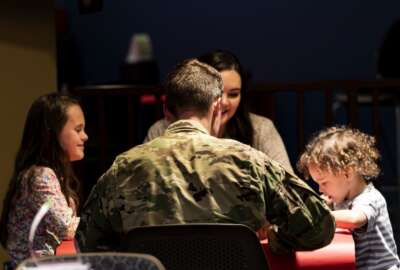Congress, DoD’s latest efforts to solve recruiting woes
From transforming the recruiting workforce to pushing through a number of legislative efforts - here's how DoD and Congress are fixing the recruitment crisis.
The first cohort of warrant officers to ever obtain a military occupational specialty in recruiting graduated Thursday, marking a turning point in how the Army brings in prospective soldiers amidst a historic recruitment slump.
The officers, designated as 420T, will focus on talent acquisition and retention, data analytics, labor market analysis and marketing. The service has long cast a wide net with its marketing campaigns, which is expensive and doesn’t reach any particular audience.
“The Army ultimately is a brand, just like any other company. And so we have to analyze the market out there. There are different types of reports that exist just for most companies to identify the type of demographic, what those people are into, what they’re interested in, what motivates them. And that’s the type of thing that we’re looking at diving deeper into within our assigned areas to ensure that we are marketing messaging the right way,” Chief Warrant Officer 2 Sasha Adams Gibson, one of the 420T graduates, told reporters Wednesday.
The 25 officers will arrive at their units at the end of summer and will stay in place for up to five years, which will provide consistent leadership and reduce the disruptions caused by frequent transitions since the service relies on involuntary tours to fill its recruiting ranks. Through strengthening their relationships with key stakeholders such as schools and community organizations and developing a deeper understanding of a particular geographical area and its demographics, the 420T warrant officers will ultimately serve as a conduit between their communities and Army leadership and allow the service to streamline its recruiting efforts.
“Most of our officers have never served in recruiting, which leads to a lot of transition. You can imagine, even this summer — lots of transition,” Col. Rick Frank, the Army Recruiting and Retention College commandant, told reporters. “As a former recruiting deputy commander and battalion commander, I see the value these new subject matter experts bring instantly to the team. 420T will advise their commanders by synchronizing market analytics, intelligence, expenditures, relationships and strategy with data-driven insights that ultimately help our recruiters continue to succeed.”
The officers went through a rigorous assessment and attribute-based selection process, which was informed by a job analysis of what the occupation will turn into in the future.
“This is the first time in our history where we have actually used an assessment process like this to select a conventional occupation in the Army. The one thing I would like to highlight about this process is it allowed us to really test eliminating bias in a process,” Col. Christine Rice, lead officer in charge of workforce redesign, said.
The Army plans to bring on two more cohorts – the second cohort of officers will go through the training later this year and the third cohort will start the training in 2025.
Phasing out involuntary recruiting tours and bringing on permanent talent acquisition specialists is only one way the service has been working to address its recruiting woes.
For nearly a decade, the Army has not been able to meet its recruitment targets but 2024 is shaping up to be a better year for the service partly due to the success of the future soldier prep course. The program that helps new recruits meet military standards and go into basic training has graduated over 18,000 soldiers with a 95% success rate.
Army Secretary Christine Wormuth said she is “feeling a lot better” about recruiting this year, although she didn’t want to be overconfident.
Meanwhile, alarmed lawmakers, who have been putting pressure on DoD leaders to fix the recruitment crisis, are pushing through a number of measures in the 2025 defense policy bill in hopes of turning the tide.
The Senate Armed Services Committee, for example, has introduced an amendment that could improve access to high schools and colleges for military recruiters. The committee also wants the DoD to establish a Military Entrance Processing Command processing pilot, which would accelerate medical record reviews.
Meanwhile, Sen. Jerry Moran (R-Kan) just introduced the Military and Educational Data Integration Act, which would allow state and local schools to access information about students who enlist in the military, such as their score on the Armed Forces Qualification Test, the highest level of education obtained and the area of expertise or military occupational specialty.
Copyright © 2024 Federal News Network. All rights reserved. This website is not intended for users located within the European Economic Area.






